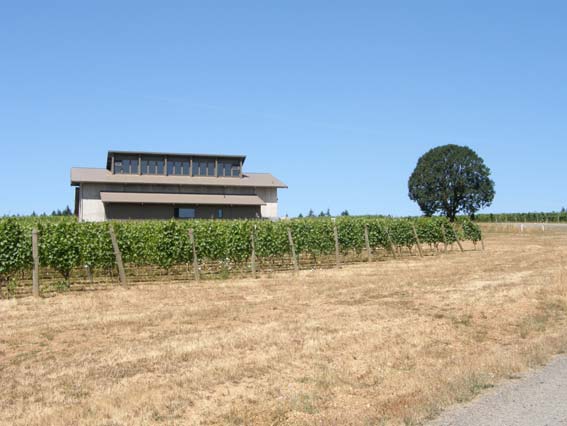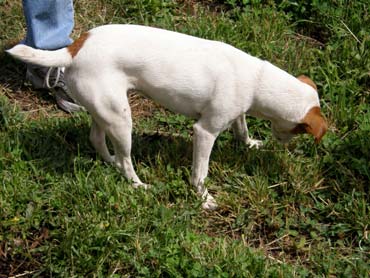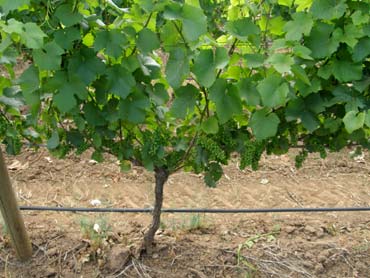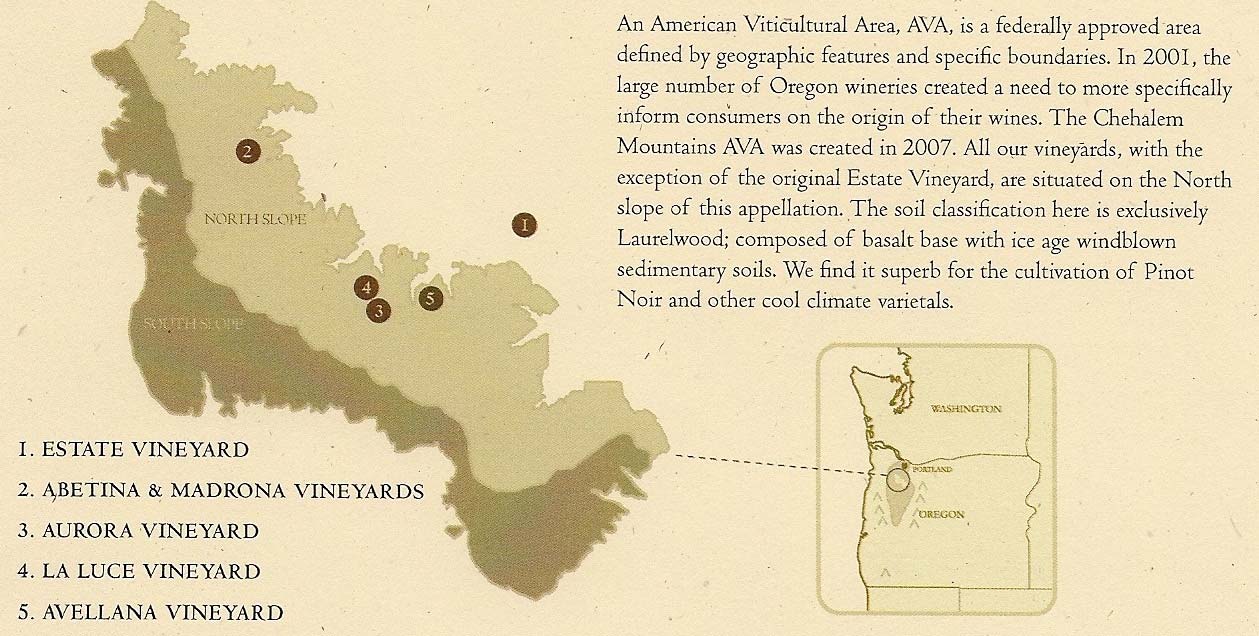Memorable Winery Visits
No trip to Oregon is complete without some visits with old friends and new acquaintances. I managed to
squeeze in several memorable wine tasting soirees with several of my friends tagging along. Shea Wine
Cellars, Anam Cara Cellars, Laura Volkman, and Ponzi Vineyards were all extremely cordial and left me with
many wonderful Pinot memories.
Shea Wine Cellars
Shea Vineyard now consists of 200 hillside acres, of which 140 acres are planted to Pinot Noir and 5 acres to
Chardonnay. The vineyard faces south at an elevation of 320 to 625 feet and is divided into two hills, named
East Hill and West Hill separated by a valley containing native plants and trees. The original vines of Pommard
and Wädenswil clones were planted on their own roots. Inevitably, phylloxera afflicted the vineyard and
planned replanting progressed over the ensuing years, reaching completion in 2005. The newer plantings
include the Dijon clones 114, 115, 777 and 828. The vineyard has never been irrigated except for new
plantings during the first year.
Grapes from this impeccably maintained site are highly sought after by many of Oregon’s top wineries
including: Andres’s Vat, Antica Terra, Beaux Freres, Bergstrom, Broadley, Elk Cove, Francis Tannahill, J.K.
Carrier, Ken Wright Cellars, Panther Creek Cellars, Penner-Ash, Raptor Ridge, Revana, Stevenson- Barrie,
Scott Paul Wines, St. Innocent and Torii Mor. In the past, grapes were sent to Manfred Krankl at Sine Qua Non
in California (last vintage 2003), but now grapes destined for California go to Loring Wine Co., Pali Wine Co.,
Auteur and Roessler.
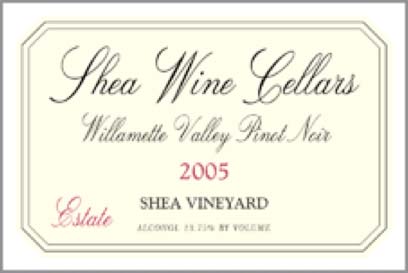
Since 1996, Dick has had his own label, Shea Wine Cellars. 25% of the vineyard
production is held back for Dick’s own label. The rest of the vineyard output is sold
by the acre, usually cropping 2-2.5 tons per acre. There have been several
winemakers for Shea Wine Cellars. Experienced tasters have talked about a
certain “Shea-ness” that seems to be expressed in the wines from this vineyard. A
consistent floral aroma and a dark red fruit character with spice seems unusually
clear and unique to this vineyard.
The Shea Wine Cellars Pinot Noirs are designated as Estate (a blend of several blocks), block or clone
designates which vary from year to year, and a special reserve wine labeled “Homer.” Dick Shea is a baseball
fan, but bears no relation to Shea Stadium in New York. Dick’s spouse and business partner, Diedre Shea.
often compares Dick to Homer Simpson, so the name “Homer” has dual meaning. The Homer cuvee is from
the best barrels and is the most voluptuous of the lineup, needing several years to reach its prime drinking
window. When I visited Dick and Diedre and their new winemaker, Drew Voit, at their winery at Shea Vineyard,
we all sat down and tasted through a vertical of Shea Wine Cellars Homer. Dick, himself, had never done this,
so it was a special treat for him as well as for me. The Homer release is a blend of the best barrels in the Shea
cellar and is intended to have good longevity. The wine is aged in 75%-80% new oak. 250-300 cases are
produced each year using primarily clones 115, 777 and 2A and occasionally Pommard. Photo below (left to
right, Prince, Drew, Dick, and Diedre).
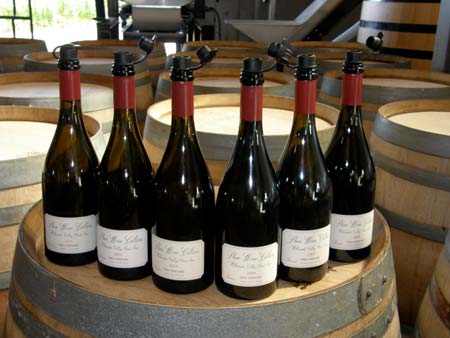
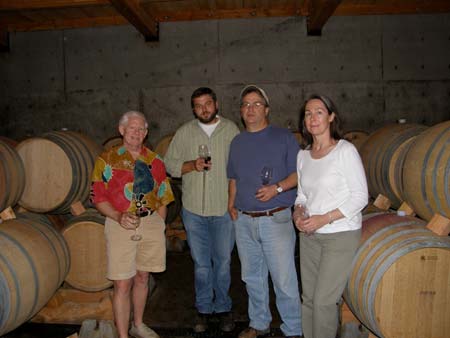
All the wines had intense color with 2005 being the darkest. Dick believes that the leaf pulling he employs in
his vineyard toughens and thickens the skins leading to less mildew and more color and flavor. There is
significant vintage variability which is further influenced by winemaker differences. These are big fruit-driven
Pinot Noirs but not jammy or overwrought.
2003 Shea Wine Cellars Homer Shea Vineyard Willamette Valley Pinot Noir
14.9% alc., 145 cases, $65. A very hot
vintage. making it difficult to reign in alcohols.
·
Lovely scents of Bing cherry, violets, exotic woods and char.
Rich and juicy palate of black cherries with velvety tannins and an appealing roundness in the mouth. Subtle
oak runs through and adds interest. No hint of over ripeness as one would anticipate.
2004 Shea Wine Cellars Homer Shea Vineyard Willamette Valley Pinot Noir
14.5% alc., $75. “Vintage of the decade”
according to Dick.
·
Appealing minerality, earthiness and charcoal embracing the rich dark fruits. Saucy, fat and
lush with velvety tannins and a long, long finish. A seamless wine of great charm and clearly the star of this
vertical tasting. That said, the 2005 and 2006 vintages should surpass it in years to come.
2005 Shea Wine Cellars Homer Shea Vineyard Willamette Valley Pinot Noir
14.25% alc., $75. Winemaker Chris
Mazepink (2005-2006). A moderate vintage with rain at harvest.
·
Fruity and floral scents with delicious black
raspberry flavor and a tangy finish. A little smoke on water is evident in this and the 2006 vintage due to
cooperage choices. More acidity this vintage. There are still some well-integrated tannins to shed and this will
continue to improve in the bottle. Great verve.
2006 Shea Wine Cellars Homer Shea Vineyard Willamette Valley Pinot Noir
14.75% alc., $75.
·
A precocious wine that is
highly aromatic featuring black cherries, raisin, mocha and herbs. Intense and lush chocolate-covered black
cherry fruit that lasts and lasts on the finish. Excellent now but still showing primary fruit and will get even
better in a couple of years.
Before departing, winemaker Drew Voit offered some barrel samples of the 2007 vintage, the first to be vinified
in the new winery (photo below). The 2007 Estate was blessed with tremendous raspberry and cherry fruit.
The 2007 East Hill was darker and more brooding with reticent fruit and big tannins making it hard to approach.
Shea Wine Cellars Pinot Noir and Chardonnay are sold primarily through a mailing list. The website is
www.sheawinecellars.com. The winery is not open to the public at this time.
Anam Cara Cellars
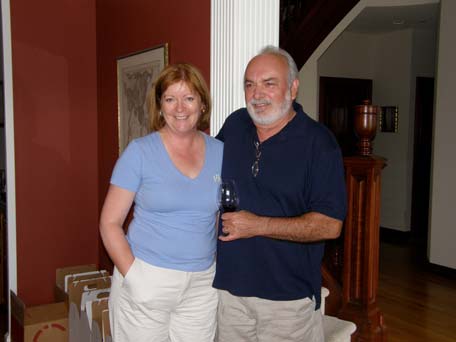
Nick and Sheila Nicholas farm a 30-acre vineyard planted in 2000 and 2001 located on the south east slopes
of the Chehalem Mountains, just north of the town of Newberg. Lying between 450 and 650 feet in elevation,
the vineyard’s well drained soils are primarily Jory series. Five blocks of Pinot Noir are planted to Pommard,
114, 115, 667 and 777 clones. Originally the property was an overgrown walnut, plum and hazelnut orchard
with a neglected Christmas tree forest and included a quaint farmhouse dating from 1902 and several wooden
outhouses. The couple have completely renovated the property and have built a spacious home overlooking
the vineyard. Farming is sustainable, with emphasis on organic and biodynamic practices, with the goal to
become LIVE certified in the future. The grapes from the estate vineyard have been highly sought after by
Tony Soter (Soter Vineyards), Brooks Wines, and Daedelus Cellars whose winemaker, Aron Hess, also makes
the wines for Anam Cara Cellars.
I couldn’t take my eyes off of the winery dog, “Digger,” who is in charge of gopher control in the vineyard and
never stopped searching for gophers the whole time I walked the beautiful vineyard which was sporting plump
clusters of Pinot Noir.
The words Anam Cara are Celtic for “friend of my soul” and symbolize the journey the Nicholas’s have taken to
make their wine and the relationship they have with the vineyard. The label depicts the vineyard symbolizing
the owners’ relationship with their land, and with each new friend who shares their wine.
I was impressed by the 2005 lineup of Pinot Noirs (see Volume 6, Issue 36). I briefly
tasted the 2006 Anam Cara Cellars Reserve. It is following in the footsteps of the excellent 2005 version with hi-toned black cherry fruit, beautifully spiced and oaked, with a
long, sweet finish.
Anam Cara wines can be acquired by phone, 503-537-9150, or through the website at
www.anamcaracellars.com. Limited Edition Wine Club members receive twice yearly mailings of six bottles of
limited production Anam Cara Cellars estate wines including Pinot Noir, Riesling, and Gewürztraminer (a small
amount of the latter two white varieties are also grown on the estate vineyard). Anam Cara is open by
appointment at the Chehalem Mountain vineyard. Nick and Sheila are always interested in walking their
vineyard with guests and opening a bottle or two if supplies permit. They also host a Labor Day Open House in
their vineyard. This past year they brought guests into the middle of the vineyard where the four blocks of
Pinot Noir converge and encouraged them to sample the grapes from four clones, then shared unblended
barrel samples from the same blocks, and finally offered samples of finished wines. The 2006 Estate and
Reserve Pinot Noirs will be released on Thanksgiving weekend as well as a limited release of their special
bottlings, Heather and Mark, though the Mark is a well-endowed wine that might be held back until next March.
Laura Volkman Vineyards
This is a new, small, family owned, boutique producer located in Newberg, Oregon. I have been impressed
with the Pinot Noirs and Chardonnay. Well, maybe that is putting it lightly, for the 2006 Rachel Estate and
2006 Jacob Estate are among the best Pinot Noirs I have drank all year and both will be in my All-American list
for 2008. I have bought and drank several bottles of the two Pinot Noirs and tested others blindly on the wines
to confirm my wild enthusiasm. The wines have consistently shined.
Laura makes all the winegrowing decisions herself, performs practically all the physical work in the vineyard,
and for the most part, won’t let anyone else touch the vines. In the winery, she is so intense in everything she
does, her very tolerant husband (bless him!), chidingly says, “She takes every bottle personally.” She likens her
passion and dedication to an author writing a great book who can completely lock into the job at hand. “I have
blinders on from April until the end of crush,” she says.
Of all the many grape varieties, Pinot Noir is the most temperamental, a fickle prodigy if you will, and the one
that can be brought to perform brilliantly only through meticulous parenting in the vineyard and in the winery.
This explains why some of the world’s greatest Pinot Noirs come from very small producers who can
personally nurse the frivolous grape every step of the way. Laura Volkman personifies this ideal and her wines
show the results.
The Laura Volkman Vineyard is located about a half mile from August Cellars (a cooperative facility in
which several winemakers lease space) in Newberg. Together with her husband, she bought a small farm
several years ago, cleared the land and planted vines. Her first releases were from the 2004 vintage. The
labels are quite striking and display artwork depicting Laura in her vineyard (by watercolor artist Terry Peasley).
I just had to meet Laura and so I did right after IPNC. Her small and charming tasting room is shown below
along with her two children Rachel and Jacob, after whom her wines are named. I re-tasted the 2006 Rachel
and Jacob Estate Pinot Noirs and they were stellar as were the 2007 versions of the same wines. The wines
strike a beautiful balance between flashy flavor and character and elegant pinotosity.
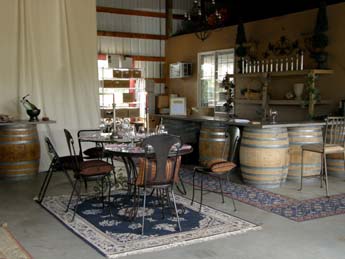
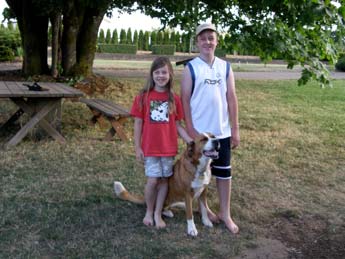

I was curious how she does it, so I asked her to give me her winemaking regimen. No secrets here, just an
artisan’s gut feeling at every step along the way. This is what she told me. “I like to dial in the yields in the
vineyard in September, based on the amount of heat units we receive during the season - very important for
wine quality. For example, I have been dropping more fruit the past 3 weeks (early and mid September) to
optimize color and flavor development and frequently tasting berries for maturity. As for winemaking, taste and
smell are my primary tools. With Pinot, the de-stemming process is very gentle and mostly whole berry. I cold
soak for 5 to 7 days, depending on the levels of ripeness, to extract color and tannins using a gentle punch
down process two times a day and tasting my way through the process. I planted five Pinot Noir clones in my
vineyard and I ferment each one separately using yeasts to match the clone’s aromas and flavors intrinsic to
my soils and site. Yeasts are important in enhancing phenolic compounds and using a variety of yeasts
contributes to the complexity of the wines. These yeasts are cool fermenters ranging from 77-85° F. The
ferments usually take between 7 and 10 days to go dry. Once complete, I allow the must to soak for another 5
to 7 days, depending on how the wine tastes, before pressing off to barrel. As for pressing, I go directly to
barrel on the lees using gentle gravity flow. The free run juice is aged in new French oak barrels and makes up
about half of my production. The skins are gently pressed into one and two year-old barrels. I inoculate every
barrel with M-L bacteria to kick off secondary fermentation which generally takes 2 to 3 months. After MLF is
complete, I keep the barrels topped and the wine rests until it is time to blend and bottle. Blending is part of
the “art” of winemaking - a fun but stressful period when everything needs to come together with aroma and
flavor! While I am fastidious with juice and wine analyses, you can see my winemaking is as much about smell
and taste as it is about science. Ultimately, the vineyard is really the key. Harvest is based more on palate
than numbers. The adrenaline rush is overwhelming - the chance to work with a new vintage is like falling in
love every year.”
Laura Volkman Vineyards winery address is 13000 N.E. Quarry Road, just off Highway 99W in Newberg
(August West Cellars). Tasting is by appointment. The wines are sold through a mailing list or by contacting
Laura at 503-806-4047. A limited number of specially etched magnums are available each vintage.
Ponzi Vineyards
Luisa Ponzi met our small group at the construction site of the new “green” Ponzi Winery that sits on a 42-acre
parcel between Beaverton and Newberg, perched on Chehalem Mountain. The new winery is aptly named
“Collina del Sogno,” which translates from Italian to “Place of Dreams.” The patriarch of Ponzi Vineyards, Dick
Ponzi, has been dreaming of this winery for thirty years. The 30,000-square-foot winery is a four-level gravity
flow and sustainable facility. Construction is primarily concrete and metal with wood accents. The concrete
portion of the building employs fly ash, a waste product from coal-fired power plants. Solar panels provide
energy and excess electrical power will be sold or credited back to the electrical company. The building is 80
percent buried in the ground to aid in insulation and with the reflective metal roof, there will be no need for air
conditioning. Most of the lighting is provided by strategically placed windows at the top of the building. Rain
water will be collected and stored for irrigation and fire suppression. The winery is scheduled for completion in
time for the 2008 harvest.

Ponzi Vineyards has been at the vanguard of sustainable viticulture in Oregon, obtaining LIVE certification in
2000 for the existing winery and all the vineyards. Ponzi now farms 120 estate acres in the Chehalem
Mountains and along with purchased grapes, produces 50,000 cases of multiple varieties (Pinot Noir,
Chardonnay, Pinot Gris, Pinot Blanc, Rosato, Dolcetto, Riesling, Arneis, and a desert wine, Vino Gelato)
annually.
As we sat outside the old Ponzi Winery and tasting room (which will remain open) under mature shade trees,
Luisa Ponzi reminisced about the early days of Ponzi Vineyards. Dick and his wife Nancy were hippies who
moved from Los Gatos, California and arrived in Oregon in the 1960s with three kids in tow and a dream of
producing world class Pinot Noir. Following trips to Burgundy and an extensive search for a suitable location,
they bought a 20-acre farm southwest of Portland in Beaverton, Oregon.
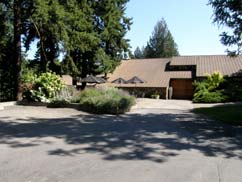
The first 11-acre vineyard was planted in 1970 and a small house and garage was
built. The garage became the first winery and was gradually expanded in a somewhat
haphazard fashion over the years with the original house becoming a hospitality center
(the old winery is pictured right). The first commercial release of Ponzi Pinot Noir was
from the 1974 vintage and released to the public in 1976. Producing limited quantities
of high-quality, handcrafted wine, Ponzi Vineyards soon established a reputation for
world-class excellence.
Dick and Nancy Ponzi were instrumental in getting state permission to allow wineries and adjoining tasting
rooms to be constructed on agricultural land in Oregon. Together, they helped found the Oregon Winegrowers
Association and the Oregon Wine Advisory Board (currently known as the Oregon Wine Board). In 1984 they
established Bridgeport Brewing Company, Oregon’s first craft brewery, and in 1998 established a regional wine
bar and bistro in downtown Dundee. Nancy Ponzi co-founded the International Pinot Noir Celebration, Oregon
Pinot Camp (for retailers), and The Salud Barrel Auction that benefits health care for seasonal workers.
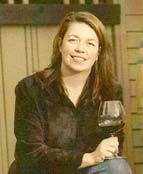
All the children worked in the vineyards growing up as Dick and Nancy Ponzi developed their
business. Today the grown children are in charge of the day-to-day management of Ponzi
Vineyards. Like her husband, Eric Hamacher, who is a noted winemaker, Luisa had intentions of
becoming a doctor and was majoring in biology when she realized medicine was not her calling.
She switched to enology, studied in Burgundy, and returned to take over the winemaking reigns
from her father in 1993. The same year the other two Ponzi children assumed full-time roles at
the winery (Maria Ponzi Fogelstrom as the Sales and Marketing Director and Michel Ponzi as
the Operations Manager).
As I sat and conversed with Luisa for a couple of hours, interrupted only once by a call about her children (she
has four), I was impressed how grounded she was. There wasn’t much winemaking jargon and gibberish or
promotion of her wines. It was refreshing to sit and sip, talking and joking about the concerns and life
experiences we all have, the kind of conversation that is so conducive to an outdoor setting over a good glass
of wine. The wines that were sampled are reviewed below. They are distributed nationally by Wilson Daniels
Ltd..
2007 Ponzi Vineyards Willamette Valley Pinot Gris
13.3% alc.,8,200 cases, $17, screw cap. Initial Pinot
Gris plantings at Ponzi date to 1978. Fermented in temperature controlled stainless steel tanks.
·
Crisp white
peach aromas and flavors with lively acidity in an Oregonian rather than Alsatian style. Ponzi excels at this
variety and I found it perfectly suited to summer dishes.
2007 Ponzi Vineyards Willamette Valley Chardonnay
11.86% alc., 542 cases, $20, screw cap. Stainless
steel fermented. Sourced from seven vineyards including Ponzi Estate and Dion Vineyards, both over 30
years old.
·
Bright and frisky with enjoyable tropical aromas and flavors including banana and pineapple. A good
food companion.
2007 Ponzi Vineyards Willamette Valley “Rosato” Rosé of Pinot Noir
12.9% alc., $17, screw cap. 100%
Pinot Noir either sourced for Rosato or the result of a saigneé. Grapes come from Ponzi Estate Vineyard and
Dion Vineyards.
·
Appealing salmon color. Pinot Noir in its most pure state, fresh and lively strawberry and red
cherry flavors. A good wine for summer BBQ.
2006 Ponzi Vineyards Reserve Willamette Valley Chardonnay
14.2% alc., 416 cases, $30. Barrel
fermented, 100% MLF Chardonnay from Dijon clones. 18 months of barrel aging and 6 months of bottle aging. Unfiltered.
·
Buttery and fruity but retains brisk acidity. Mildly viscous in the mouth with attractive notes of
tropical fruits, tart apple and honey and a little spice to boot. Restrained but showy and a winner on all counts.
2006 Ponzi Vineyards Willamette Valley Pinot Noir
13.5% alc., 6,000 cases, $35. Fermented in small lots
with five days of cold soak. Manual punchdowns before lightly pressing at dryness. Aged in 30% new French
oak for 11 months. Bottled without fining or filtration and aged five months in bottle before release.
·
A decent
Pinot with simple aromas and flavors of cherries, cranberries and strawberries with an oaky component.
Slightly velvety in texture with a good acidic charge on the clean finish.
2006 Ponzi Vineyards Reserve Willamette Valley Pinot Noir
14.3% alc., 700 cases, $60. The flagship Pinot Noir of Ponzi
Vineyards and an outstanding wine in each vintage. The blend is
selected from older vines of Ponzi’s Madrona, Abetina and Aurora
vineyards as well as purchased fruit. Winemaking is
similar as for the Willamette Valley blend except a seven day postfermentation
maceration is used to increase structure and length.
Aged in 50% new French oak barrels for 20 months. Bottled unfined and
unfiltered and aged in bottle for five months before release.
·
A complete wine of great breeding. Lovely
aromatics featuring bright cherry and Satsuma plum fruit nicely spiced. Gorgeous stone fruit with subtle earth,
oak and tea notes expands in the mouth leaving a lasting and memorable impression. Very harmonious,
smooth and stylish. Still tight and will need another year or two to reach a more lofty peak. I have been
buying this wine every vintage since 1992.
Ponzi Vineyard wines are available on the website at www.ponziwines.com. Reduced futures prices are
offered to those on the mailing list. The Abetina Vineyard Pinot Noir ($100), made in only the finest vintages,
is one of Oregon’s greatest wines. The wines are available for sampling at the original winery located at
14665 SW Winery Lane in Beaverton (open daily) and at the Ponzi Wine Bar in Dundee on Highway 99W
(also open daily). 503-628-1227.






